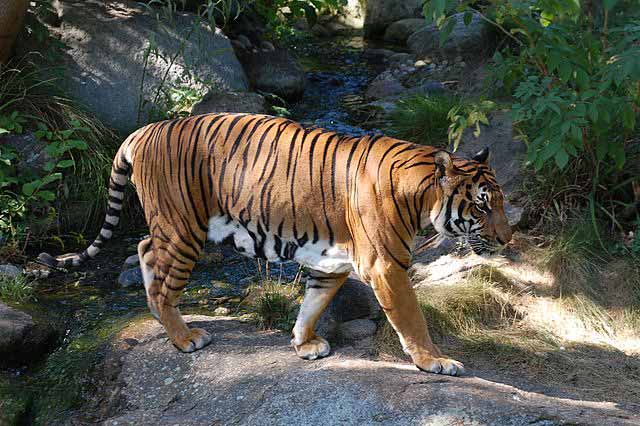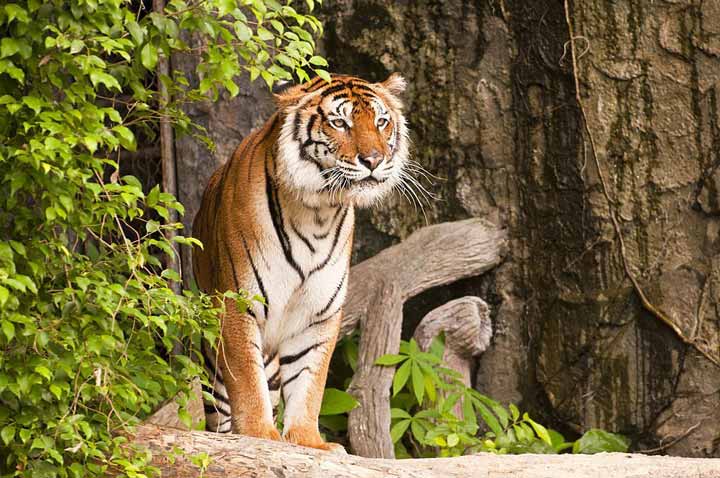The Indochinese tiger also known as Corbett’s tiger, named after Jim Corbett.
With its distinctive markings and powerful presence, this magnificent creature once roamed vast territories. Today, it faces numerous challenges, but its spirit remains unbroken.
Quick Overview
| Attribute | Details |
|---|---|
| Scientific Name | Panthera tigris tigris |
| Habitat | Forests in Southeast Asia, including Thailand, Cambodia, and Laos |
| Weight | Male: 150 to 195 kg (330 to 430 lbs) Female: 100 to 130 kg (220 to 286 lbs) |
| Length | Male: 2.55 to 2.85 meters (8.4 to 9.4 feet) Female: 2.3 to 2.55 meters (7.5 to 8.4 feet) |
| Diet | Deer, wild boar, and smaller mammals |
| Lifespan | 15 – 20 Years |
| Conservation Status | Critically Endangered |
| Estimated Population | Less than 400 in the wild |
| Primary Threats | Poaching, habitat loss due to deforestation and infrastructure development |
| Conservation Measures | Protected areas, anti-poaching patrols, and international collaborations for species protection |
Taxonomy
In 1968, a scientist named Vratislav Mazák introduced Panthera tigris corbetti for a specific tiger population. He based this classification on their unique skin color, stripe patterns, and skull sizes. This tiger was named in tribute to Jim Corbett.
In 2017, experts from the Cat Classification Task Force of the Cat Specialist Group updated the tiger’s taxonomy. They concluded that the tiger populations from mainland South and Southeast Asia are part of the primary subspecies known as P. tigris tigris.
A 2018 genetic study further supported this classification. After analyzing the genomes of 32 tiger specimens, researchers found that the tigers from Malaysia and Indochina were distinct from other Asian tigers. This research backs the idea of recognizing six unique tiger subspecies.
| Kingdom | Animalia |
|---|---|
| Phylum | Chordata |
| Subphylum | Vertebrata |
| Class | Mammalia |
| Order | Carnivora |
| Suborder | Feliformia |
| Family | Felidae |
| Genus | Panthera |
| Species | Panthera tigris |
| Sub Species | Panthera tigris tigris |
Physical Characteristics

Size-wise, while it’s smaller than the Bengal and Siberian tigers, it still holds a significant presence, showcasing the vast diversity within the tiger species.
Male Indochinese typically weigh between 150 to 195 kg (330 to 430 lbs) and measure about 2.55 to 2.85 meters (8.4 to 9.4 feet) in length. In contrast, slightly smaller females weigh 100 to 130 kg (220 to 286 lbs) and span a length of 2.3 to 2.55 meters (7.5 to 8.4 feet).
Their darker coat has short, narrow stripes, setting them apart from other tiger subspecies. This darker hue and distinctive striping pattern provide them with the perfect camouflage for the dense forests they inhabit.
Distribution and Habitat

Historically, the Indochinese tiger roamed regions spanning Myanmar, Thailand, Laos, Cambodia, Southern China, and Vietnam.
Its territories have shrunk today, with significant populations primarily in Thailand and Myanmar.
The Western Forest Complex in Thailand, especially the Huai Kha Khaeng Wildlife Sanctuary, has become a crucial refuge.
These tigers prefer tropical and subtropical moist broadleaf forests, which provide ample cover and a wide variety of prey.
Diet and Hunting Behavior

As an apex predator, the Indochinese tiger’s diet is predominantly carnivorous. It hunts medium to large-sized ungulates, including various deer species and wild boar.
The tiger’s hunting strategy combines patience, stealth, and raw power. It often stalks its prey silently, using the dense forest as cover, before launching a swift and powerful ambush, relying on its strong jaws and sharp claws to subdue its meal.
Reproduction and Lifespan

The cycle of life for the Indochinese tiger begins early. Females reach sexual maturity in 3-4 years, while males take longer, maturing in 4-5 years.
After mating, a gestation period of about 104-106 days follows, culminating in the birth of 2-3 cubs.
These cubs, under the watchful eyes of their mother, learn the ways of the wild. In their natural habitat, these tigers can live up to 15 years, a lifespan that might see a slight increase in captivity.
Threats and Conservation
The majestic Indochinese tiger faces a barrage of threats. Poaching, driven by the illegal wildlife trade, is the most significant. The demand for tiger parts remains high, especially in traditional medicine markets.
Additionally, habitat loss due to logging, agricultural expansion, and urbanization further threatens their existence. However, hope remains.
Conservation initiatives, both local and international, are intensifying efforts to protect this subspecies. Habitat restoration, anti-poaching patrols, and community education are some measures in place.
Cultural Significance
The tiger holds a revered place in many Southeast Asian cultures. It’s not just an animal but a symbol of strength, power, and courage.
Folk tales, legends, and even religious texts in the region often feature this majestic creature, emphasizing its deep-rooted significance in the cultural and spiritual life of the people.
Conclusion
The story of the Indochinese tiger is one of resilience, challenges, and hope. As the modern world continues to encroach upon its territories, the narrative of this tiger becomes a poignant reminder of our responsibilities.
It underscores the importance of coexistence, conservation, and the celebration of the rich biodiversity that our planet offers.
FAQs
The Indochinese tiger is a subspecies of the tiger, native to Southeast Asia. It’s scientifically known as Panthera tigris tigris.
Historically, they roamed regions spanning Myanmar, Thailand, Laos, Cambodia, southern China, and Vietnam. Today, significant populations are primarily in Thailand and Myanmar.
The Indochinese tiger is genetically distinct from other mainland Asian tiger populations and has a darker ground coloration with short and narrow single stripes.
Being apex predators, their diet consists mainly of medium to large-sized ungulates, including various deer species and wild boar.
In their natural habitat, these tigers can live up to 15 years. This lifespan might see a slight increase in captivity.
Exact numbers are challenging to determine due to their elusive nature and vast territories, but estimates suggest the population is critically low less than 400, making conservation efforts vital.
Males typically weigh between 150 to 195 kg (330 to 430 lbs) and measure about 2.55 to 2.85 meters (8.4 to 9.4 feet) in length. Females are smaller, weighing 100 to 130 kg (220 to 286 lbs) and measuring 2.3 to 2.55 meters (7.5 to 8.4 feet) in length.



